Security Compliance: What You Need to Know
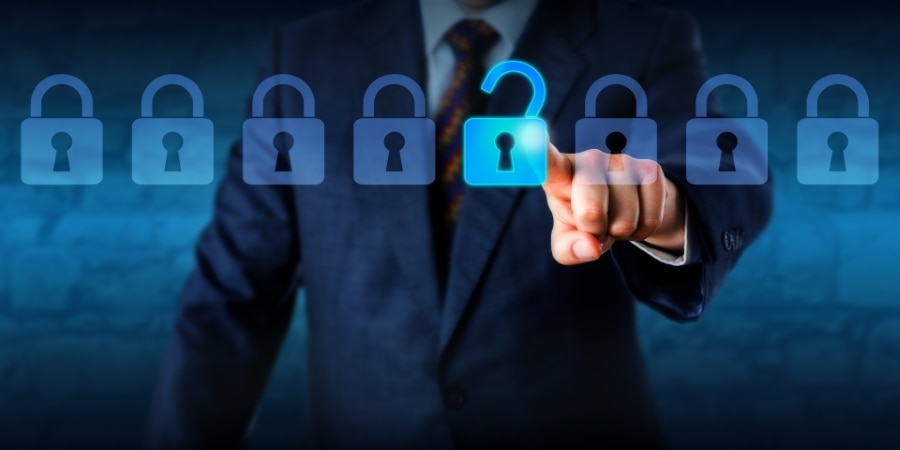
On this page:
What is Security Compliance?
Security compliance is about putting the right controls in place to protect critical business assets.
It means complying with a set of standards and requirements set by an independent third party.
It requires adherence to widely recognized security compliance guidelines and includes technical as well as administrative security measures throughout an organization.
These measures are central elements of a robust security compliance program, along with policies, procedures, and regular audits.
Through these actions, security compliance minimizes risks and ensures that an organization is following industry best practices.

Definition of Security Compliance
At its core, security compliance is ensuring adherence to defined security standards and government regulations.
More importantly, it’s an integral aspect of the company’s larger risk management strategy.
It brings technical safeguards in line with administrative protocols.
This alignment helps to make sure both the physical infrastructure and operational security factors of an organization are protected.
A well-designed security compliance program includes well-defined policies and procedures that guide your work.
Regular audits support these best practices, so you can remain compliant and adaptive.
Importance Across Industries
For heavily regulated sectors such as healthcare and finance, security compliance is critical.
It improves operational efficiency by reducing the risks associated with data breaches.
The Payment Card Industry Data Security Standard (PCI DSS) has put compliance front and center on the IT security landscape.
It is fundamental to safeguarding credit cardholder data.
A strong compliance framework builds trust and credibility with customers and other stakeholders, resulting in increased customer loyalty and brand reputation.
Key Regulations and Standards
Complying with key regulations and standards is one of the most prominent aspects of strong security compliance.
These frameworks offer repeatable, measurable, and scalable approaches to mitigating security threats. They ensure that your organization is equipped to meaningfully address the dynamic and complicated world of data privacy and protection.
By complying with these regulations, you’re not just protecting sensitive information—you’re fostering operational integrity and trustworthiness.
Regulatory requirements set the tone for organizational policies and practices, forcing organizations to implement strong security standards that meet other industry standards.
Understanding the latest compliance standards and regulations is key to maintaining your competitive advantage.
It helps to ensure that your practices are in line with rapidly changing legal expectations.
GDPR Overview
The General Data Protection Regulation (GDPR) serves as a crucial framework for data protection, giving EU citizens greater control over their data.
Key principles like data minimization and user consent are key to developing transparent data practices that help foster trust.
Failure to comply can result in significant penalties and reputational harm, underscoring the importance of proactive compliance efforts.
GDPR has set the tone for data security practices around the globe, serving as a model for how organizations all over the world should protect their data.
HIPAA Overview
The Health Insurance Portability and Accountability Act (HIPAA) is one of the most important US federal laws that healthcare organizations must follow.
Above all, it lays down privacy and security guidelines that protect patient information.
Compliance is critically important because the repercussions for violations are significant and can entail harsh penalties.
Following the rules of HIPAA means you are legally compliant and increases your patients’ trust in you and your organization’s credibility.
PCI DSS Overview
This standard is crucial for companies that accept card payments in any way.
It provides a roadmap of essential operations for securing cardholder data, preventing financial and legal fallout.
Compliance is a key factor in keeping your customers confident in your payment systems, guaranteeing safe and secure transactions.
ISO/IEC 27001 Overview
ISO/IEC 27001 is an international standard for information security management systems.
Getting certified shows an organization’s commitment to security and empowers organizations to protect sensitive information in a systematic manner.
Ongoing compliance is critical, keeping you in step with compliance standards, and making sure your security solutions are growing and developing with new threats.
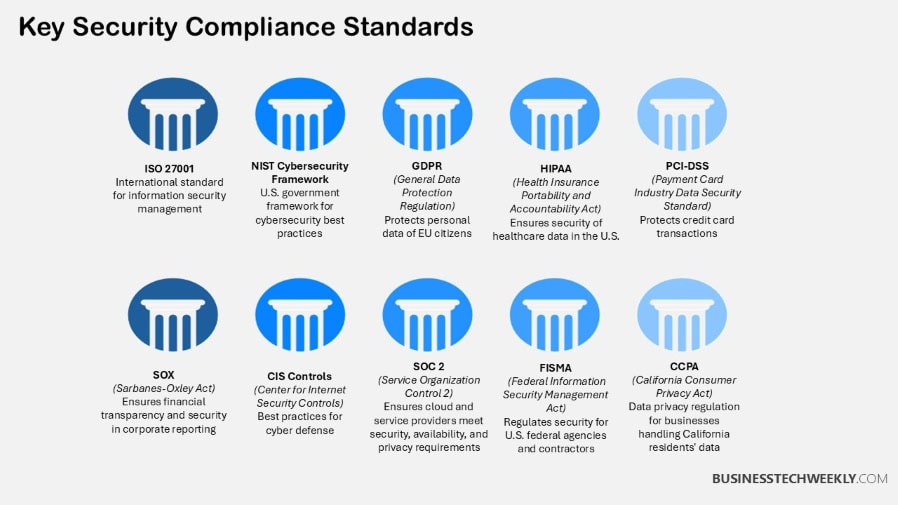
Best Practices for Security Compliance
1. Conduct Regular Audits
Regular audits are pivotal in assessing your compliance status and identifying vulnerabilities.
By systematically examining security practices, organizations can refine their strategies and align them with compliance requirements.
Third-party auditors bring an objective perspective, offering valuable insights that might otherwise be overlooked.
Their assessments can inform risk management strategies and lead to significant improvements in your compliance efforts.
Such audits ensure that security practices remain robust and adaptive to new challenges.
2. Implement Robust Policies
Holistic security policies are the bedrock of compliance.
Well-defined roles and responsibilities in these frameworks define acceptable behavior and decision-making for employees.
With rapidly changing regulations at every level of government, routinely re-evaluating and refreshing policies is essential to ensure they stay relevant.
Strong policies act as a guiding document for an organization.
They ensure security is woven into the culture and the fabric of the day-to-day operations, creating a continuous compliance mindset.
3. Train Employees Effectively
Accountability through employee training is one of the key components to cultivating a culture of security compliance.
Regular, updated training programs ensure that all staff members are aware of new or evolving security threats and compliance requirements.
By weaving in simulations and real-world scenarios, you can make training more effective and help to minimize human error and strengthen your overall security posture.
By investing in inclusive and comprehensive training, organizations develop a well-trained and diverse workforce that’s better equipped to advance security initiatives.
4. Monitor Security Systems
Continual monitoring of security systems is critical to identifying and responding to incidents as quickly as possible.
Cybersecurity real-time threat detection is essential in this process.
Having the right advanced tools at your fingertips allows for a faster response to potential threats and vulnerabilities.
Activity monitoring is the backbone of continued, compliant adherence to regulatory requirements, further fortifying an organization’s security posture.
5. Update Technology Regularly
Staying current with technology can significantly reduce the risk of security vulnerabilities.
Patch management is critical in remediating known vulnerabilities, helping to make sure that systems meet security baselines.
Staying current with updates will improve your security posture and help keep you in compliance.
By taking a proactive approach to technology upgrades, the organization better fortifies their cybersecurity posture against cybercriminals and other cyber threats.
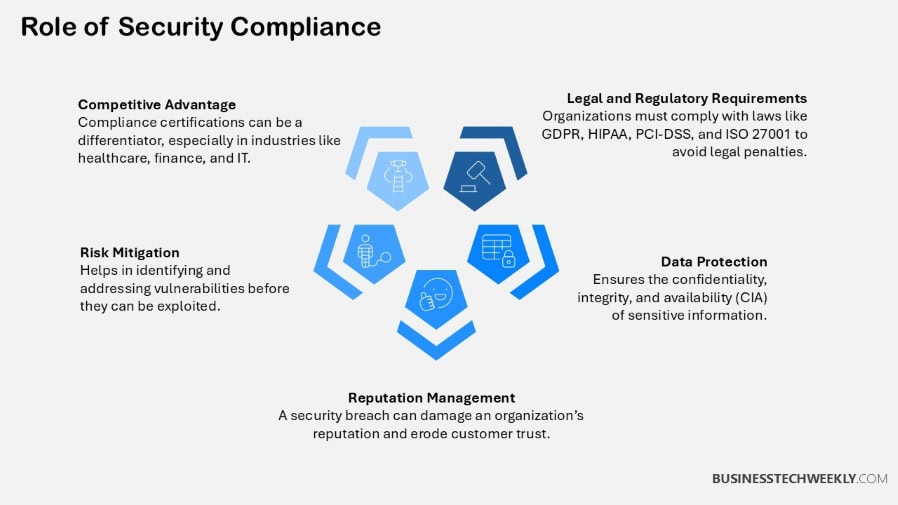
Challenges in Security Compliance
Understanding security compliance is one of the biggest challenges facing organizations in today’s digital landscape.
These are just some of the common hurdles, such as knowing, tracking and complying with various regulations and frameworks. It’s no surprise that many organizations are responsible to multiple standards like ISO 27001, SOC 2, and GDPR.
This complexity requires deep expertise to ensure proper compliance with a myriad of regulatory obligations.
Having proper documentation in place can go a long way towards making these burdens less cumbersome, allowing for effective communication about compliance needs.
Understanding Complex Regulations
The multifaceted, confusing world of compliance regulations frequently daunts enterprises.
Specialized expertise is absolutely essential for you to even begin to interpret these requirements correctly.
Effective internal communication is key to make sure all of your team members are on the same page with their compliance requirements.
Good documentation is key to making these processes more manageable, allowing organizations to comply with regulatory requirements more efficiently.
Keeping Up with Changes
Keeping up with the ever-shifting landscape of compliance requirements is crucial. Compliance teams need to stay on top of these updates and pivot strategies as needed.
Continuously engaging with industry associations on security compliance enables organizations to maintain an awareness of how trends and requirements are changing and evolving.
Automation should be central to any approach, with 95% of compliance professionals using technology solutions to adapt to these changes.
Managing Costs Effectively
As augmentation budgets dry up, achieving and maintaining compliance can become financially burdensome.
Strategic allocation of resources will be needed to minimize costs while reducing risk.
While it can be expensive upfront, investing in compliance can save money in the long run by avoiding costly security breaches.
Automation and technology help simplify processes, making them less complex and less costly.
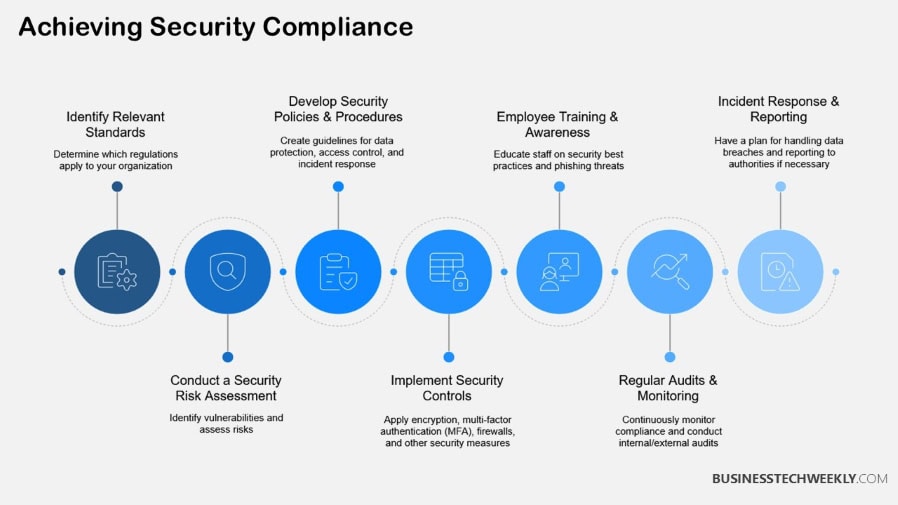
Benefits of Security Compliance
Protecting Sensitive Data
The overarching purpose of security compliance is to safeguard sensitive data from a security breach.
When compliance is built into the software development lifecycle, vulnerabilities are identified and addressed early on, minimizing risks before the software is released.
Employing data encryption and restricting access are just two ways compliance helps protect your consumers’ personal and financial information.
These actions protect business continuity by reducing the incidence of data breaches.
Enhancing Customer Trust
Security compliance plays a huge role in developing customer trust.
Clear and honest data practices help build customer confidence in your data handling, providing you with a market advantage.
This trust builds customer loyalty, resulting in repeat business.
Having a positive compliance reputation doesn’t just keep customers happy but can even attract new customers.
Avoiding Legal Penalties
Failure to comply with security regulations can have disastrous legal consequences.
For many organizations, the threat of enormous fines and other sanctions loom large if they do not achieve compliance.
Proactive compliance efforts can go a long way in mitigating these legal risks.
Establishing a culture of compliance should be the first step in protecting yourself from potential legal disasters.
Improving Overall Security Posture
Building security compliance into development improves overall security posture.
When you automate the entire process, you can eliminate the time to identify issues by up to 90%, boosting overall efficiency.
This proactive risk management not only contributes to a heightened state of readiness and organizational reputation, but it signals a commitment to protecting data.
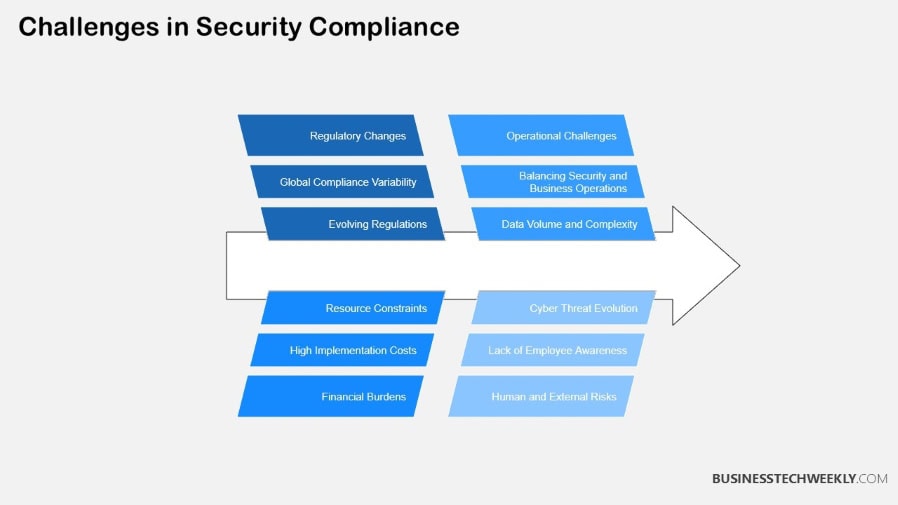
Key Points to Consider
Security compliance protects your data and keeps your customers coming back.
When you follow the correct standards, it provides you a well-defined roadmap to building a positive reputation based on trustworthiness. There are challenges, but the upside is far greater.
- Security compliance gives companies the assurance that they are protecting company data and assets while remaining in lockstep with regulatory requirements. It is built on technical and administrative safeguards and is a central component of an organization’s risk management strategy.
- This is because attaining certifications in security frameworks is critical. We need to go further than certification to meet the growing and changing cyber threats and achieve more holistic security.
- Security compliance is important in all industries, but particularly so in the healthcare and financial industries. It protects sensitive data, improves operational efficiency, and reduces the likelihood of costly data breaches.
- Adhering to key regulations and standards, such as GDPR, HIPAA, PCI DSS, and ISO/IEC 27001, provides structured approaches to managing security risks and helps maintain organizational integrity and reputation.
- Having best practices in place increases security compliance. Consistent audits, firm policies, thorough employee training, constant monitoring, and regular technology updates enable organizations to stay a step ahead of those looking to cause harm.
- Overcoming challenges in security compliance requires understanding complex regulations, keeping up with changes, and managing costs effectively, all of which contribute to protecting sensitive data, enhancing customer trust, and avoiding legal penalties.
Frequently Asked Questions
What is security compliance?
That’s where security compliance management comes in—you want your business to adhere to all cybersecurity regulations and industry standards.
It’s about implementing security controls and the right policies to safeguard sensitive data and established systems.
As a bonus, effective security compliance protects you from potential legal action and increases trust with customers.
Why are key regulations and standards important for security compliance?
Regulations and standards, such as NIST and the Cybersecurity Framework, offer a roadmap for effective security compliance to protect our crucial data and systems.
They provide a baseline for consistency and reliability in cybersecurity compliance practices, helping your organization avoid costly data breaches or legal penalties.
What are some best practices for security compliance?
Smart practices involve regular audits, employee education, and ongoing policy improvement as part of an effective security compliance program.
Implementing strong access controls and encryption enhances information security compliance, ensuring sensitive information remains secure amidst shifting cybersecurity regulations.
What challenges can arise in maintaining security compliance?
Challenges include fulfilling the constantly evolving regulatory compliance landscape and managing compliance costs.
Keeping employees informed and integrating new technologies can pose significant compliance challenges.
Striking the right balance between security needs and operational efficiency remains an ongoing concern for organizations.
How does security compliance benefit businesses?
Security compliance management not only helps organizations build customer trust but also protects them from costly data breaches.
Beyond the general benefits of sustainability, effective security compliance can create a competitive advantage and help strengthen overall business reputation.
While compliance in itself is about avoiding legal fines, overall compliance improves an organization’s security posture.
What is the role of employee training in security compliance?
Strong employee training and culture are essential components of an effective security compliance program.
This approach ensures that staff is aware of cybersecurity regulations and potential threats.
By keeping employees trained on security practices, organizations can mitigate human error, a prevalent vulnerability. When incidents occur, educated employees are more adept at recognizing and responding to security incidents.
How can businesses stay updated on security compliance regulations?
Companies need to be signed up for their industry’s newsletters and be members of their industry’s professional associations.
Engaging in cybersecurity compliance programs and attending conferences and workshops is helpful.
Frequent consultations with legal and IT experts aid in staying aligned with the newest security compliance standards.

